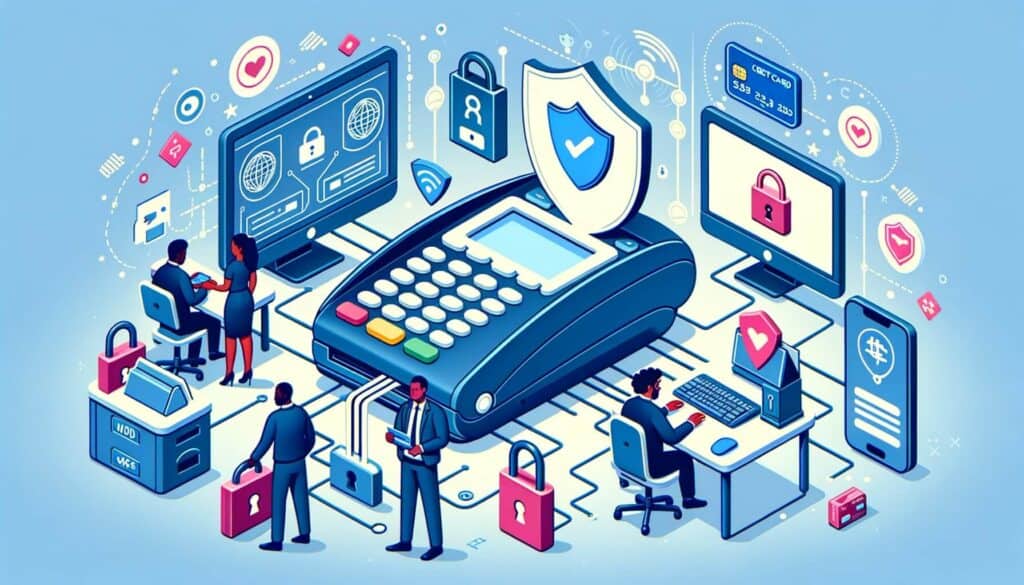
By American April 3, 2025
In today’s digital age, secure payment processing systems have become an essential component of any business that accepts online payments. With the increasing prevalence of cyber threats and data breaches, it is crucial for businesses to prioritize the security of their customers’ payment information.
In this comprehensive guide, we will explore the importance of secure payment processing, the key components of a secure payment processing system, different types of systems available, how to choose the right system for your business, step-by-step implementation guide, best practices for ensuring secure payment processing, common challenges and solutions, and frequently asked questions.
Understanding the Importance of Secure Payment Processing
The importance of secure payment processing cannot be overstated. When customers make online payments, they trust that their sensitive information, such as credit card details, will be handled securely. Failure to protect this information can lead to severe consequences, including financial loss, damage to reputation, and legal liabilities. According to a study by the Ponemon Institute, the average cost of a data breach in 2020 was $3.86 million. This staggering figure highlights the need for businesses to invest in robust payment processing systems.
Key Components of a Secure Payment Processing System
A secure payment processing system consists of several key components that work together to ensure the protection of customer data. These components include encryption, tokenization, secure sockets layer (SSL) certificates, fraud detection and prevention tools, and compliance with industry standards such as Payment Card Industry Data Security Standard (PCI DSS). Let’s delve into each of these components in detail.
Encryption: Encryption is the process of converting sensitive data into an unreadable format to prevent unauthorized access. In a secure payment processing system, encryption is used to protect customer payment information during transmission and storage. Advanced encryption algorithms, such as Advanced Encryption Standard (AES), are employed to ensure the highest level of security.
Tokenization: Tokenization is a technique that replaces sensitive data, such as credit card numbers, with unique tokens. These tokens have no intrinsic value and cannot be reverse-engineered to obtain the original data. Tokenization helps to minimize the risk of data breaches by ensuring that sensitive information is not stored in the merchant’s system.
Secure Sockets Layer (SSL) Certificates: SSL certificates are essential for establishing a secure connection between a customer’s browser and the merchant’s website. They encrypt the data transmitted between the two parties, preventing interception and tampering. SSL certificates are indicated by a padlock symbol in the browser’s address bar, providing customers with visual assurance of a secure connection.
Fraud Detection and Prevention Tools: Fraud detection and prevention tools are crucial for identifying and mitigating fraudulent activities. These tools employ various techniques, such as machine learning algorithms and behavioral analysis, to detect suspicious transactions and patterns. By flagging potential fraud, businesses can take immediate action to protect their customers and prevent financial losses.
Compliance with PCI DSS: The Payment Card Industry Data Security Standard (PCI DSS) is a set of security standards established by major credit card companies to ensure the protection of cardholder data. Compliance with PCI DSS is mandatory for businesses that handle credit card information. It involves implementing security measures, such as network firewalls, regular system updates, and vulnerability scans, to safeguard customer data.
Types of Secure Payment Processing Systems
There are several types of secure payment processing systems available, each with its own features and benefits. The most common types include hosted payment gateways, integrated payment gateways, and mobile payment solutions.
Hosted Payment Gateways: Hosted payment gateways redirect customers to a secure payment page hosted by a third-party provider. This type of system is easy to implement and requires minimal technical expertise. The payment page is typically branded to match the merchant’s website, providing a seamless user experience. However, hosted payment gateways may have limitations in terms of customization and control over the payment process.
Integrated Payment Gateways: Integrated payment gateways are integrated directly into the merchant’s website or application, providing a seamless payment experience for customers. This type of system offers more flexibility and control over the payment process. However, it requires more technical expertise to implement and maintain.
Mobile Payment Solutions: With the increasing use of smartphones, mobile payment solutions have gained popularity. These solutions enable businesses to accept payments through mobile devices, such as smartphones and tablets. Mobile payment solutions can be integrated with existing payment systems or used as standalone solutions. They offer convenience and flexibility for both merchants and customers.
Choosing the Right Secure Payment Processing System for Your Business
Choosing the right secure payment processing system for your business is crucial to ensure smooth and secure transactions. Consider the following factors when selecting a system:
1. Security Features: Evaluate the security features offered by the payment processing system. Ensure that it supports encryption, tokenization, SSL certificates, and fraud detection tools. Additionally, check if the system is compliant with PCI DSS.
2. Integration: Determine how well the payment processing system integrates with your existing infrastructure, such as your website or point-of-sale system. Seamless integration will streamline your payment process and enhance the customer experience.
3. Cost: Consider the cost of implementing and maintaining the payment processing system. Compare pricing models, transaction fees, and any additional charges associated with the system. Ensure that the system offers value for money and aligns with your budget.
4. Scalability: Assess the scalability of the payment processing system. As your business grows, you may need to handle a higher volume of transactions. Ensure that the system can accommodate your future needs without compromising security or performance.
5. Customer Support: Evaluate the level of customer support provided by the payment processing system provider. Prompt and reliable support is essential in case of any technical issues or concerns.
Implementing a Secure Payment Processing System: Step-by-Step Guide
Implementing a secure payment processing system requires careful planning and execution. Follow these steps to ensure a smooth implementation process:
1. Assess Your Current System: Evaluate your existing payment processing system and identify any vulnerabilities or areas for improvement. This assessment will help you understand the specific requirements and goals for implementing a secure system.
2. Research and Select a Provider: Conduct thorough research to identify reputable payment processing system providers. Consider factors such as security features, integration capabilities, cost, and customer support. Shortlist a few providers that meet your requirements and request demos or trials to assess their suitability.
3. Develop an Implementation Plan: Create a detailed implementation plan that outlines the steps, timeline, and responsibilities for implementing the new payment processing system. Consider factors such as data migration, system integration, staff training, and testing.
4. Data Migration: If you are transitioning from an existing system, ensure a smooth data migration process. Back up your data and transfer it securely to the new system. Verify the accuracy and integrity of the migrated data to avoid any discrepancies.
5. System Integration: Integrate the payment processing system with your website, point-of-sale system, or other relevant platforms. Test the integration thoroughly to ensure seamless communication and data flow between systems.
6. Staff Training: Provide comprehensive training to your staff on how to use the new payment processing system. Ensure that they understand the security protocols, fraud detection tools, and any other features relevant to their roles.
7. Testing and Quality Assurance: Conduct rigorous testing of the payment processing system to identify and resolve any issues or bugs. Test various scenarios, such as different payment methods, currencies, and transaction volumes, to ensure the system performs as expected.
8. Go-Live and Monitoring: Once all testing is complete, schedule a go-live date for the new payment processing system. Monitor the system closely during the initial period to identify any issues and address them promptly.
Best Practices for Ensuring Secure Payment Processing
To ensure secure payment processing, businesses should follow these best practices:
1. Regularly Update Software: Keep your payment processing system and all associated software up to date with the latest security patches and updates. Outdated software may have vulnerabilities that can be exploited by cybercriminals.
2. Use Strong Authentication: Implement strong authentication measures, such as two-factor authentication (2FA) or biometric authentication, to verify the identity of users accessing the payment processing system. This adds an extra layer of security and reduces the risk of unauthorized access.
3. Monitor and Analyze Transactions: Implement real-time transaction monitoring and analysis tools to detect and prevent fraudulent activities. Set up alerts for suspicious transactions and investigate them promptly.
4. Educate Employees: Train your employees on security best practices, such as recognizing phishing emails, using strong passwords, and avoiding suspicious websites. Regularly remind them about the importance of secure payment processing and the potential consequences of security breaches.
5. Regularly Conduct Security Audits: Perform regular security audits to assess the effectiveness of your payment processing system’s security measures. Identify any vulnerabilities or weaknesses and take appropriate actions to address them.
Common Challenges and Solutions in Secure Payment Processing
While implementing and maintaining a secure payment processing system, businesses may encounter various challenges. Here are some common challenges and their solutions:
1. Compliance with PCI DSS: Achieving and maintaining compliance with PCI DSS can be complex and time-consuming. To overcome this challenge, businesses should partner with a payment processing system provider that offers built-in PCI compliance features and guidance.
2. Integration Issues: Integrating a payment processing system with existing infrastructure, such as websites or point-of-sale systems, can be challenging. To ensure smooth integration, work closely with the system provider and seek assistance from technical experts if needed.
3. Data Breaches: Data breaches pose a significant risk to secure payment processing. To mitigate this risk, businesses should implement robust security measures, such as encryption, tokenization, and regular security audits. Additionally, having a response plan in place can help minimize the impact of a data breach.
4. Fraudulent Activities: Fraudulent activities, such as stolen credit card information or identity theft, can result in financial losses and damage to reputation. Implementing fraud detection and prevention tools, along with regular transaction monitoring, can help identify and prevent fraudulent activities.
Frequently Asked Questions about Secure Payment Processing Systems
Q1. What is a secure payment processing system?
Answer: A secure payment processing system is a set of technologies and processes that ensure the secure handling of customer payment information during online transactions. It includes encryption, tokenization, SSL certificates, fraud detection tools, and compliance with industry standards such as PCI DSS.
Q2. How does encryption work in a secure payment processing system?
Answer: Encryption in a secure payment processing system involves converting sensitive data, such as credit card numbers, into an unreadable format using encryption algorithms. This ensures that even if the data is intercepted, it cannot be deciphered without the encryption key.
Q3. What is tokenization in secure payment processing?
Answer: Tokenization is a technique used in secure payment processing to replace sensitive data, such as credit card numbers, with unique tokens. These tokens have no intrinsic value and cannot be reverse-engineered to obtain the original data. Tokenization helps minimize the risk of data breaches by ensuring that sensitive information is not stored in the merchant’s system.
Q4. How can businesses ensure compliance with PCI DSS?
Answer: To ensure compliance with PCI DSS, businesses should implement security measures such as network firewalls, regular system updates, vulnerability scans, and encryption of cardholder data. They should also undergo regular security audits and assessments to validate their compliance.
Q5. What are the benefits of using a mobile payment solution?
Answer: Mobile payment solutions offer convenience and flexibility for both merchants and customers. They enable businesses to accept payments through mobile devices, such as smartphones and tablets, providing a seamless payment experience. Mobile payment solutions also offer features such as mobile wallets and contactless payments, which are becoming increasingly popular among consumers.
Conclusion
In conclusion, secure payment processing systems are essential for businesses that accept online payments. By prioritizing the security of customer payment information, businesses can protect themselves from financial loss, reputational damage, and legal liabilities.
Understanding the key components of a secure payment processing system, different types of systems available, and best practices for implementation and maintenance is crucial for ensuring smooth and secure transactions. By following the guidelines outlined in this comprehensive guide, businesses can enhance their payment security and provide a seamless payment experience for their customers.




